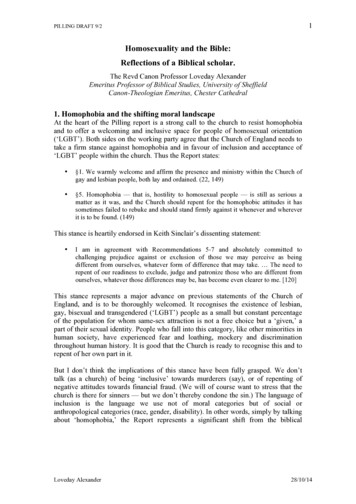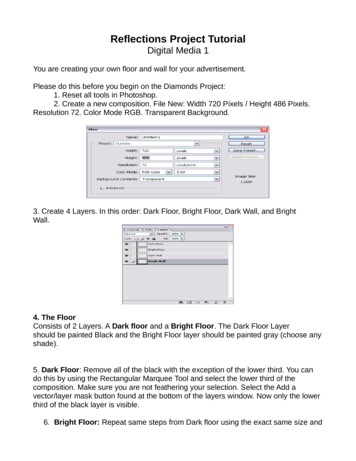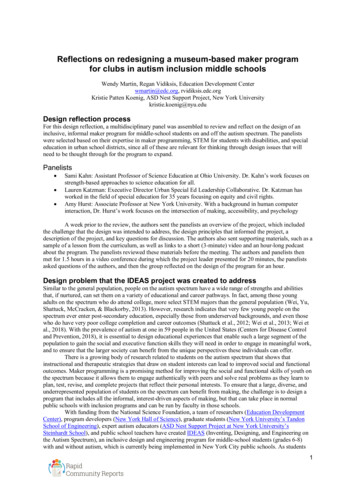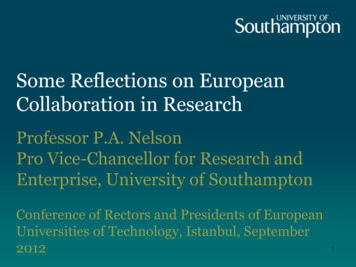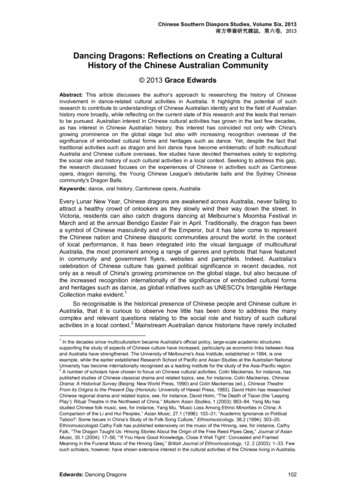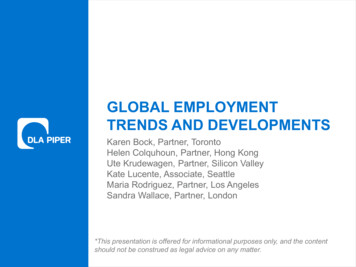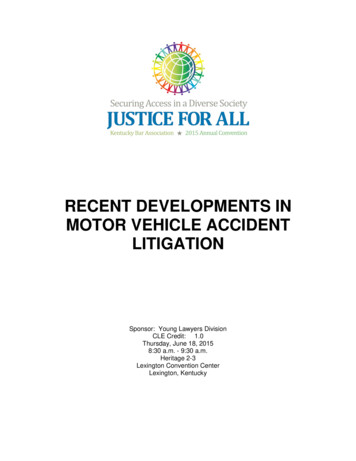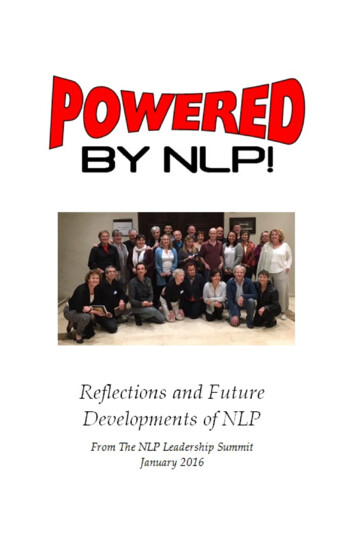
Transcription
Reflections and FutureDevelopments of NLPFrom The NLP Leadership SummitJanuary 2016
Published in Englandby GWiz Publishing(A division of The GWiz Learning Partnership)Oakhurst, Mardens Hill, Crowborough, E. Sussex. TN6 1XLTel ( 44) 1892 309205info@gwiznlp.comwww.gwiznlp.comFirst published 2016.10 9 8 7 6 5 4 3 2 1 GWizNLP 2016All rights reserved.No part of this publication may be reproduced, stored ortransmitted in any way, without prior permission of the author andpublisher.ISBN: 978-0-9548800-2-6ii
Contents123ForewordvIntroductionixReflections: Rachel Hott1Building a Worldwide NLP Community7Community, Collaboration & Connection: Heidi Heron9Conflict Resolution for Unprofessional Behavior: L. Michael Hall13Reflections: Judith Lowe17NLP: Today & Tomorrow?25How do we decide what is and is not “NLP”?: L. Michael Hall27The Elder Columns: Jaap Hollander, Lucas Derks, Bruce Grimley &Lisa de Rijk29Reflections: Luzia Wittman53The Leadership of NLP: Laureli Blyth57Reflections: Anneke Durlinger59Why is NLP so important today?: Karl Nielsen63Reflections: Ueli R. Frischknecht73Credibility: Professional NLP77NLP – Profession and Professionalism: L. Michael Hall79Modelling Exemplars for the Successful Spread of NLP: Lisa de Rijk& Melody Cheal81The Future of E Learning and Technology in Training NLP: KarenMeager93Reflections: Reb Veale97About the Authors99iii
iv
ForewordJoe ChealImagine.Imagine twenty-nine NLP ‘elders’ from across the worldcoming together to talk To talk about NLP and its future To talk about their hopes and visions as to what NLP can become.To talk about what happens next.Imagine no international borders.Imagine helpfulness instead of hierarchy,Imagine playfulness instead of posturingand participation instead of positioning.Welcome to the 2016 Leadership Summit ‘Colloquium’.A Quick BackgroundBack in 2012, a collection of NLP ‘elders’ were invited to gather inLondon at the NLP Conference. This was the first meeting of the‘NLP Leadership Summit’.An elder, in this case, is defined as somebody who: Has 15 years minimum experience in the field of NLP,Is recognised as a Leader in NLP (either as a trainer and/orsomeone who is leading people to NLP rather than standingon the apex),v
Foreword Is willing to sign up to the declaration, purpose and values(published on the website www.nlpleadershipsummit.org).Soon, more elders were invited and the list from around the worldcurrently adds up to about 130 people (listed on the website). Thegroup have met again each year at the NLP Conference.The meeting in January 2016 was a ‘special’ three day event for folksto meet and take more time to discuss and work through the thingsthat mattered. This event became known as a ‘colloquium’ (aninformal meeting for an exchange of views), where all individualscame to the room as equals.Folks in attendance were:Anneke DurlingerAnneke MeijerBrian van der HorstBruce GrimleyCaitlin ZahariaFabiola i
Powered by NLP!Frank PucelikGilles RoyHedi RoulinHeidi HeronJaap HollanderJoe ChealJohn McWhirterJohn McLaughlanJudith LoweKaren MaegerKarl NielsenLaureli BlythLisa de RijkLucas DerksLuzia WittmannMelody ChealMichael HallNandana NielsenRachel HottReb VealeShelle Rose CharvetSteven LeedsUeli R. sPortugalUKUSAGermanyUSAUKCanadaUSASwitzerlandWhy This Book?From a personal perspective, as I sat listening to the experience,wisdom and collaboration in the room I thought: “Wow, if youcould only bottle this and let the wider NLP community know thepassion that these folk have for NLP, how powerful that could be.”vii
ForewordI loved the fact that although most of these folk had never metbefore, and came from vastly different schools of NLP from aroundthe world, there was no need for ego, division or divisiveness. Itwas an honour to be there and to witness what humancommunication can truly be. Here I saw the NLP presuppositions inaction.If we can’t ‘bottle’ it, we could at least record it in some way; eventhe essence of it. And hence the book idea was born, Powered byNLP!Having been editor of Acuity (the ANLP Journal) for a few years, Iknew a book could be created simply if enough people at thecolloquium wanted to contribute. Seventeen participants (half thegroup) liked the idea of a publication and wanted to add something.‘Powered by NLP!’ is a range of ideas from people in the group.Whilst all of the articles are inspired by discussions at the‘colloquium’, you will find that some are more formal in theirapproach whilst others are more about personal reflections.The content of this book is not meant to be the ‘truth’ but simplyperspectives from different people. It is, perhaps, the start of adiscussion: you might even discover different views and opinionsexpressed herein! You will also find different styles of writing andfrom an editorial perspective I have made the choice to maintain theauthors’ original spelling and grammar wherever possible(including a mix of English and US English).This book is not about ‘what the leadership summit says or thinks’.There is no ‘gospel’ here! The material comes from the individualswithin the group; so let it provoke your own agreements,disagreements and ideas.viii
IntroductionL. Michael HallForging a New Future for NLPA truly historical event occurred January 8, 9 and 10 in the coastalcity of Alicante Spain, on the Mediterranean Sea. It occurred when33 top leaders in the field of NLP came together representing 13countries and multiple languages for a conversation of a lifetime.Another ten were expected, but for family issues and other things atthe last minute they were not able to come. These leaders typicallywere key leaders in various National Associations of NLP aroundthe world— The Association of NLP of the UK, of Germany, of theNetherlands, Australia, Canada, etc. and we even had one of theoriginal co-founders of NLP with us, Frank Pucelik from theUkraine.For three full days officially from 10 am to 7 pm, and many morehours at breakfast and in the pub, we had many of theconversations that the field has needed to have for the past 40years. We actually began these four years ago when we began thehalf-day (4 hour) Summits in London prior to the NLP LondonConference. We began those Summits to know each other andbecome acquainted with each other so that it began to build trustbetween us. And what we did there was taken to a much, muchhigher level in this three-day intensive. Several commented on thelevel of trust and sense of community that has emerged among us.The Idea of a “Summit”In the world of politics, when an issue or a problem arises in acountry and it is too big, too overwhelming, too global a problemfor the leaders of one country to solve, often an invitation will goix
Introductionout to the leaders of half a dozen countries or a dozen or two dozento come together to talk about it. They call that conversation, aSummit. The Summit has no power, no organization, no army, nobudget, etc. It is just a meeting of leaders to put their heads togetherto talk about a shared problem or a shared challenge. Sometimes,however, out of such Summits, arise an Alliance that is empoweredby all of the countries.The NLP Leadership Summit is similar. The Summit, as such, has no“authority” to prescribe or control. It is a place, or perhaps moreaccurately an experience, wherein the top leaders come together toencounter a shared problem or challenge. That’s what we havedone. And what has emerged, ever so slowly (well, for my tastes) isa growing sense of collaboration and willingness to take someeffective actions to address the problems of “negative press,”misrepresentations, lack of an international unifying body, the“cowboys” giving NLP a bad name, etc.One problem in the field of NLP has been the divisiveness—theseparating into individualistic camps. This has led to the Elephantin-the-room problem that every person new to NLP excitedly andsurprisingly asks, “Do the leaders of NLP talk to each other?” “Dothey get along?” “Why are there these divisions and camps?”“Why don’t the leaders apply NLP to themselves?” For years, manyof us talked this way primarily with regard to Richard Bandler andJohn Grinder. Then we spoke about it regarding those who havebeen carrying the mantle of leadership after them.The good news is that today we can say, “The top leaders of NLPare talking and attempting to work together.” “And they are alsoforging ahead looking for how we can co-create the kind of futurefor NLP that we all want— a future wherein the model/s of NLP arerecognized, found credible, and is progressing in the world as itenables people to change their lives for the better and become theirbest selves.”x
Powered by NLP!What we did during the Summit was experience co-leadership.That’s not easy. I think it could be said that everyone of the leaderspresent is a person of strong opinions and a person who gets thingsdone. They are not just talkers. They are there, in part, and selffunded themselves to come because they are successful in their ownright in using NLP. Many (probably most) are or were trainers,entrepreneurs who run or had run Training Centers. Others aretherapists, consultants, coaches, or researchers. And as the sayinggoes, leading a group of strong-willed people like that is “trying toherd cats.”In facilitating the group, Heidi Heron and myself, set up theprocesses so that everyone had a opportunity to be in front of thegroup and present what one of the three (or more) smaller groupshad deliberated on. We also facilitated conversations within thelarger group— and many times it became very animated. Yet,amazingly, we truly kept applying the NLP Communication Modelto ourselves so the conversations were respectful and considerateeven when the conversations became intense. I felt proud of thegroup and everyone in the group.xi
Introductionxii
A Personal Reflection on the SummitRachel Hott, PhDIt was my first time attending an NLP Leadership summit. I onlyknew five people out of thirty, one being my husband/businesspartner, Steven Leeds. As I listened to the participants introducethemselves, all of whom had been involved in NLP for at least 15years in the areas of training, research, writing and/or innovation, Iwas very impressed. I liked being part of an interesting and excitinggroup of NLPers who like me had made NLP their life.Michael Hall and Heidi Heron, who organized the summit,seamlessly provided a unifying structure for the three days. Sittingin a circle we discussed varied topics related to NLP, its past,present and most importantly, its future. There were three tables forbreak out groups of ten. When breaking into these groups we hadfour designated roles: facilitator, scribe, timekeeper and speaker. Wewere also asked (jokingly?) to make sure each group had its owndesignated 'mis-matcher.' The discussions included, "What are thestandards needed in an NLP Practitioner Training?," "What ishappening with NLP research?," "Is NLP a profession?", "Are weconflict adverse?", "How do we incorporate technology into trainingand public relations?", "What are the foundations of NLP?", "What'snew in NLP?", What is our vision for the future of NLP?", and"What defines an NLP Leader?"At the get go we reminded ourselves to demonstrate respect foreach other, eliminate bad mouthing, not speak over each other andkeep our comments brief. Everyone in the group remainedrespectful when disagreeing. Together we created the safe space weall wanted. While speaking over each other and going beyond ourallotted time did occur (I was definitely one of the culprits).1
Powered by NLP!Fortunately our facilitators respectfully "reeled us in" when thishappened.What did I learn and what did I take away? I learned about theNicaragua University, thanks to Karl and Nandana, that provides aPhD in psychology with an emphasis in NLP where students do nothave to reside in Nicaragua to attend. I also found out about someoffspring techniques, Mind Sonar, designed by Jaap Hollander andSocial Panorama, designed by Lucas Derks. Each technique usesaspects of NLP and is being taught separately from a typicalpractitioner training. I learned that Catalan from Romania, who isthe leader of the INLPT group has created an association fortraining psychotherapists in NLP in thirteen countries.At times my new learning was on a smaller chunk size, duringinformal conversations. One discussion was about modeling andwhat modeling is and isn't. There was also considerabledisagreement about the length of an NLP certification training andwhat specific curriculum "should," be included. I also found out thatnot all NLP trainings have the same curriculum. Some NLPtrainings don't teach Milton Model and some include MetaPrograms in their Practitioner curriculum while others include it intheir Master Practitioner curriculum. I learned that some NLPtrainers only do demonstrations without describing or discussingthe techniques and instead just tell participants to do the exercise.We did not always arrive at a conclusion, but the interactions werelively and thought provoking.The most spontaneous moments were also the most memorable forme. There are two that stand out for me. One occurred in a smallgroup when I was the facilitator. Our group members were; myself,Melody, Shelly, Nadana, Heidi, Anneke M., Fabiola, Jaap, Ueli, andJudith. Our group was discussing how do we get other people tocome to NLP trainings, or "How do we get people to play with us?"2
ReflectionsOur first innovation was to leave the summit meeting room and gooutside to the delightfully sunny weather and sit by the patio. Afterwe began discussing how to "get people to play", an idea wasgenerated that involved using ourselves to describe on a 'YouTube'style video why we found NLP useful. The excitement in our groupwas palpable. We
L. Michael Hall Forging a New Future for NLP A truly historical event occurred January 8, 9 and 10 in the coastal city of Alicante Spain, on the Mediterranean Sea. It occurred when 33 top leaders in the field of NLP came together representing 13 countries and multiple languages for a conversation of a lifetime.
